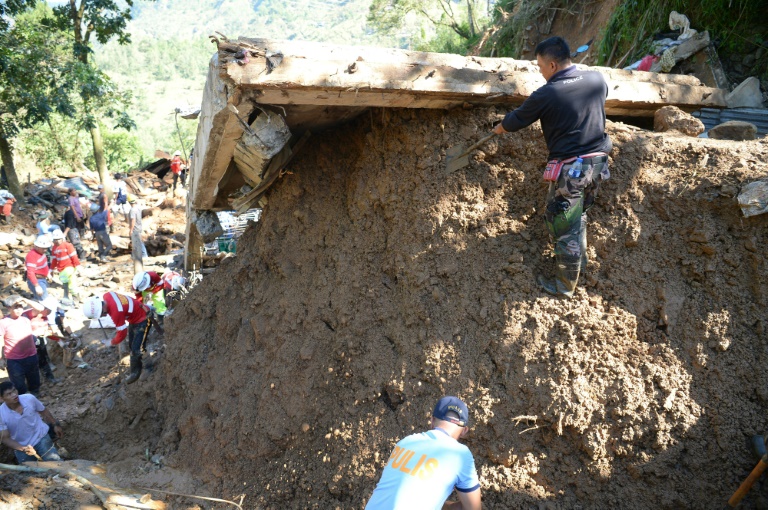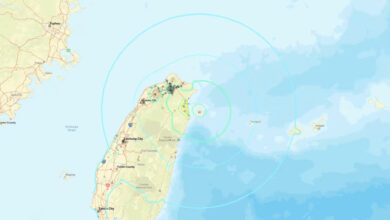
The death toll in Typhoon Mangkhut hit 74 on Tuesday, Philippine authorities said, as rescuers used their bare hands to sift through a massive landslide in which dozens were feared killed in the worst-hit region.
The typhoon, the most powerful to strike this year, smashed homes and flooded key agricultural regions in the northern Philippines before battering Hong Kong and southern China with fierce winds and heavy rain.
As Hong Kong gradually got back on its feet, residents from teachers to refugees mobilised to help clean up after Mangkhut, which smashed windows, felled at least 1,000 trees and sent skyscrapers swaying.
The violent storm killed four in China’s southern province of Guangdong and the toll rose Tuesday to 74 on the Philippines’ northern Luzon island according to police, with that number expected to further climb.
Up to 40 people are still feared buried in the landslide in Itogon unleashed Saturday as the typhoon stalled over the area and dumped a month’s worth of rain in a matter of hours.
“While I said there is a 99-percent chance that all of them are dead, there is still that one-percent chance,” Itogon Mayor Victorio Palangdan told AFP.
“The rescue effort will continue until the president orders us to stop,” he said.
Because the landslide destroyed roads, authorities have been unable to bring heavy equipment into the area to accelerate the search. As a result the teams were using human chains to extract debris.
The effort has been getting progressively more difficult because the rain-soaked soil has started to harden in the scorching Philippine sun. Crews have been using water to try to soften up the soil.
The area was primed for disaster before Mangkhut hit, as it came on the heels of nearly a month of continuous monsoon rains that left the already hazardous area soggy and dangerously loose.
Almost all the storm’s victims were killed in dozens of landslides unleashed along the Cordillera mountain range, a key gold mining area.
‘King of storms’
Many of those buried in Itogon were small-scale gold miners and their families who took refuge in a building abandoned by a large mining firm.
The Philippines has a poor record of regulating mining, with tunnel collapses and landslides regularly killing people in other gold-rush areas in recent years.
Tearful families surrounded a whiteboard bearing names of the dead and missing as others inspected recovered bodies in an attempt to identify their loved ones.
“Of course his death hurts,” Jocelyn Banawul told AFP after her cousin’s corpse was pulled from the debris.
“But he was found, he’s not buried there anymore.”
Across northern Luzon, which produces much of the nation’s rice and corn, farms were flattened and flooded, with the authorities saying crop losses would likely total more than $250 million.
That could add to the Philippines’ inflation woes and worsen a spike in rice prices that has hit hard the nearly quarter of the nation’s population that survives on less than $2 a day.
Clean-up underway
In Hong Kong, which was whacked with gusts of more than 230 kilometres per hour (142 mph) that sent buildings swaying and water surging into homes and shopping malls, workers were still busy cleaning up the damage.
In the seafront eastern residential neighborhood of Tseung Kwan O, dozens of local volunteers set to work on Tuesday.
The community, stacked with tower blocks, was mauled by winds and waves which tore up paths and roadways on the coastal promenade.
Teacher Simon Ng brought his two young daughters down to help with the clean-up.
“I would go out here for jogging, bring my kids here to play. Now it looks like a post-war situation,” Ng told AFP.
At the height of the deluge, windows in tower blocks and skyscrapers were smashed as people cowered inside, and some roads were waist-deep in water.
The government of the high-rise city described the damage as “severe and extensive” with more than 300 people injured.
The storm made landfall in mainland China late Sunday, killing four in Guangdong including three hit by falling trees.
Authorities there had evacuated more than three million people and ordered tens of thousands of fishing boats back to port before the arrival of what Chinese media dubbed the “King of Storms”.




